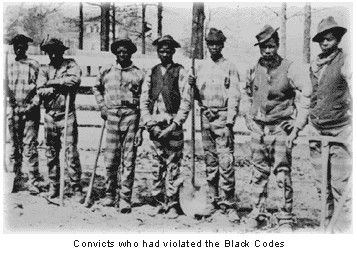The Black Codes
In 1865 and 1866, state governments in the South enacted laws designed to regulate the lives of the former slaves. These measures, differing from state to state, were actually revisions of the earlier slave codes that had regulated that institution.
 Some common elements appeared in many of the Codes:
Some common elements appeared in many of the Codes:
- Race was defined by blood; the presence of any amount of black blood made one black
- Employment was required of all freedmen; violators faced vagrancy charges
- Freedmen could not assemble without the presence of a white person
- Freedmen were assumed to be agricultural workers and their duties and hours were tightly regulated
- Freedmen were not to be taught to read or write
- Public facilities were segregated
- Violators of these laws were subject to being whipped or branded.
Existence of the black codes was taken as evidence by many Northerners (especially the
Radical Republicans) that the South had not really been subdued. Slavery had simply taken a new form.
The
Freedmen`s Bureau worked to halt enforcement of many of these laws and the Republican state governments (imposed by the North) repealed the measures.
When Reconstruction was over, many of the Black Code elements would reappear in
Jim Crow legislation.
 Some common elements appeared in many of the Codes:
Some common elements appeared in many of the Codes: